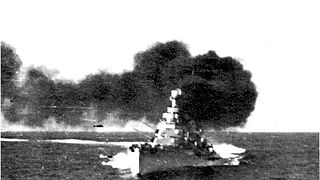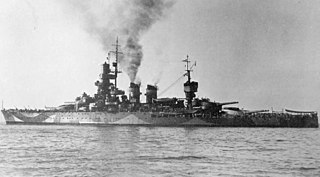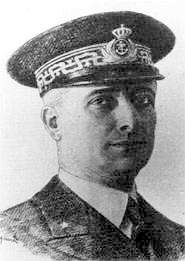
The Battle of Cape Matapan was a naval battle during the Second World War between the Allies, represented by the navies of the United Kingdom and Australia, and the Royal Italian navy, from 27 to 29 March 1941. Cape Matapan is on the south-western coast of the Peloponnesian Peninsula of Greece.

HMS Jamaica, a Fiji-class cruiser of the Royal Navy, was named after the island of Jamaica, which was a British Crown Colony when she was built in the late 1930s. The light cruiser spent almost her entire wartime career on Arctic convoy duties, except for a deployment south for the landings in North Africa in November 1942. She participated in the Battle of the Barents Sea in 1942 and the Battle of North Cape in 1943. Jamaica escorted several aircraft carriers in 1944 as they flew off airstrikes that attacked the German battleship Tirpitz in northern Norway. Late in the year she had an extensive refit to prepare her for service with the British Pacific Fleet, but the war ended before she reached the Pacific.

HMS Hasty was an H-class destroyer built for the Royal Navy during the mid-1930s. She was assigned to the Mediterranean Fleet until the beginning of World War II. The ship transferred to Freetown, Sierra Leone, in October 1939 to hunt for German commerce raiders in the South Atlantic with Force K. Hasty returned to the British Isles in early 1940 and covered the evacuation of Allied troops from Namsos in early May 1940 during the Norwegian Campaign. She was transferred back to the Mediterranean Fleet shortly afterwards and participated in the Battle of Calabria and the Battle of Cape Spada in July 1940. The ship took part in the Battle of Cape Matapan in March and evacuated British and Australian troops from both Greece and Crete in April and May. In June, Hasty participated in the Syria-Lebanon Campaign and was escorting convoys and the larger ships of the Mediterranean Fleet for the next year. During the Second Battle of Sirte in March 1942 she defended a convoy from an Italian battleship and several cruisers. While covering another convoy from Alexandria to Malta in June 1942 during Operation Vigorous, Hasty was torpedoed by a German motor torpedo boat and was so badly damaged that she had to be scuttled.

The Battle of Calabria known to the Italian Navy as the Battle of Punta Stilo, was a naval battle during the Battle of the Mediterranean in the Second World War. Ships of the Regia Marina were opposed by vessels of the Mediterranean Fleet. The battle took place 30 nmi to the east of Punta Stilo, Calabria.

The Battle of Cape Spartivento, known as the Battle of Cape Teulada in Italy, was a naval battle during the Battle of the Mediterranean in the Second World War, fought between naval forces of the Royal Navy and the Italian Regia Marina on 27 November 1940.

The Zara class was a group of four heavy cruisers built for the Italian Regia Marina in the late 1920s and the early 1930s. The class comprised the vessels Zara, Fiume, Gorizia, and Pola, the last of which was completed to a slightly different design. The ships were a substantial improvement over the preceding Trento-class cruisers, incorporating significantly heavier armor protection at the cost of the very high speed of the Trentos. They carried the same main battery of eight 203 mm (8.0 in) guns and had a maximum speed of 32 knots. Among the best-protected heavy cruisers built by any navy in the 1930s, the heavy armor was acquired only by violating the terms of the Washington Naval Treaty, which limited cruiser displacement to 10,000 long tons (10,160 t).

HMS Mohawk was one of 16 Tribal-class destroyers built for the Royal Navy shortly before the beginning of Second World War in 1939. Completed in 1938 the ship was initially assigned to the Mediterranean Fleet. She was briefly involved enforcing the arms blockade on the combatants in the Spanish Civil War in early 1939. Mohawk returned home shortly after the start of the Second World War and was assigned convoy escort duties, during which she was damaged by German bombers. She played an active role in the Norwegian Campaign of April–May 1940, escorting convoys to and from Norway.

Vittorio Veneto was the second member of the Littorio-class battleship that served in the Italian Regia Marina during World War II. The ship's keel was laid down in October 1934, launched in July 1937, and readied for service with the Italian fleet by August 1940. She was named after the Italian victory at Vittorio Veneto during World War I, and she had three sister ships: Littorio, Roma, and Impero, though only Littorio and Roma were completed during the war. She was armed with a main battery of nine 381-millimeter (15.0 in) guns in three triple turrets, and could steam at a speed of 30 knots.

Giovanni delle Bande Nere was an Italian light cruiser of the Giussano class, which served in the Regia Marina during World War II. She was named after the eponymous 16th-century condottiero and member of the Medici family. Her keel was laid down in 1928 at Cantieri Navali di Castellammare di Stabia, Castellammare di Stabia; she was launched on 27 April 1930, and her construction was completed in 1931. Unlike her three sisters, the finish and workmanship on the vessel were not rated highly. She was sunk on 1 April 1942 by the British submarine HMS Urge.

Zara was a heavy cruiser built for the Italian Regia Marina, the lead ship of the Zara class. Named after the Italian city of Zara, the ship was built at the Odero-Terni-Orlando shipyard beginning with her keel laying in July 1928, launching in April 1930, and commissioning in October 1931. Armed with a main battery of eight 8-inch (200 mm) guns, she was nominally within the 10,000-long-ton (10,000 t) limit imposed by the Washington Naval Treaty, though in reality she significantly exceeded this figure.

Duilio was an Italian Andrea Doria-class battleship that served in the Regia Marina during World War I and World War II. She was named after the Roman fleet commander Gaius Duilius. Duilio was laid down in February 1912, launched in April 1913, and completed in May 1916. She was initially armed with a main battery of thirteen 305 mm (12.0 in) guns, but a major reconstruction in the late 1930s replaced these with ten 320 mm (13 in) guns. Duilio saw no action during World War I owing to the inactivity of the Austro-Hungarian fleet during the conflict. She cruised the Mediterranean in the 1920s and was involved in the Corfu incident in 1923.

Gorizia was the third member of the Zara class of heavy cruisers to be built for the Italian Regia Marina in the 1930s. Named for the town of Gorizia, the ship was laid down at the OTO Livorno shipyard in March 1930, was launched in December that year and was commissioned into the fleet in December 1931. Armed with a main battery of eight 8-inch (200 mm) guns, she was nominally within the 10,000-long-ton (10,000 t) limit imposed by the Washington Naval Treaty, though in reality she significantly exceeded this figure.

Trieste was the second of two Trento-class heavy cruisers built for the Italian Regia Marina. The ship was laid down in June 1925, was launched in October 1926, and was commissioned in December 1928. Trieste was very lightly armored, with only a 70 mm (2.8 in) thick armored belt, though she possessed a high speed and heavy main battery of eight 203 mm (8 in) guns. Though nominally built under the restrictions of the Washington Naval Treaty, the two cruisers significantly exceeded the displacement limits imposed by the treaty. The ship spent the 1930s conducting training cruises in the Mediterranean Sea, participating in naval reviews held for foreign dignitaries, and serving as the flagship of the Cruiser Division. She also helped transport Italian volunteer troops that had been sent to Spain to fight in the Spanish Civil War return to Italy in 1938.

Trento was the first of two Trento-class cruisers; they were the first heavy cruisers built for the Italian Regia Marina. The ship was laid down in February 1925, launched in October 1927, and was commissioned in April 1929. Trento was very lightly armored, with only a 70 mm (2.8 in) thick armored belt, though she possessed a high speed and heavy main battery of eight 203 mm (8 in) guns. Though nominally built under the restrictions of the Washington Naval Treaty, the two cruisers significantly exceeded the displacement limits imposed by the treaty.

Bolzano was a unique heavy cruiser, sometimes considered to be a member of the Trento class, built for the Italian Regia Marina in the early 1930s, the last vessel of the type to be built by Italy. A modified version of the earlier Trento class, she had a heavier displacement, slightly shorter length, a newer model of 203 mm (8 in) gun, and a more powerful propulsion system, among other differences influenced by the Zara class that had followed the Trentos. Bolzano was built by the Gio. Ansaldo & C. between her keel laying in June 1930 and her commissioning in August 1933.

Andrea Doria was the lead ship of her class of battleships built by the Regia Marina. The class included only one sister ship, Duilio. Andrea Doria was named after the 16th-century Genoese admiral of the same name. Laid down in March 1912, the battleship was launched a year later in March 1913, and completed in March 1916. She was armed with a main battery of thirteen 305 mm (12.0 in) guns and had a top speed of 21 knots.

The Adriatic campaign of World War II was a minor naval campaign fought during World War II between the Greek, Yugoslavian and Italian navies, the Kriegsmarine, and the Mediterranean squadrons of the United Kingdom, France, and the Yugoslav Partisan naval forces. Considered a somewhat insignificant part of the naval warfare in World War II, it nonetheless saw interesting developments, given the specificity of the Dalmatian coastline.

Fiume was a Zara-class heavy cruiser of the Italian Regia Marina, named after the Italian city of Fiume, she was the second of four ships in the class, and was built between April 1929 and November 1931. Armed with a main battery of eight 8-inch (200 mm) guns, she was nominally within the 10,000-long-ton (10,000 t) limit imposed by the Washington Naval Treaty, though in reality she significantly exceeded this figure.

Carlo Cattaneo was an Italian admiral during World War II. He was killed in the Battle of Cape Matapan.





















